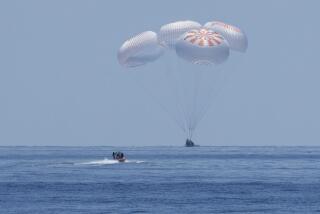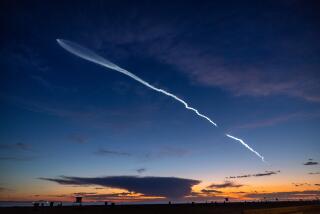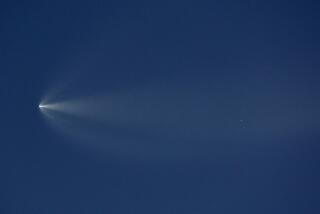NASA Plan Launches Hope for Jobs
In a development that could provide a major boost to the sagging economy in the Antelope Valley, NASA has rated Edwards Air Force Base as the top site to launch its next-generation space shuttle prototype.
A study released by the space agency examined factors such as public safety, noise, impact on general aviation and environmental effects, rating Edwards “preferred” among several competing launch sites. It identified three preferred landing sites: the dry Silurian Lake near Baker and two others in Utah and Montana.
Within 30 days, NASA will consider all technical, financial and scheduling elements before deciding whether to proceed with the prototype--called the X-33 flight test program.
But observers of the process, which began more than a year ago and involved extensive public hearings, expect the final decision to be all but a formality.
“By the time they wrap everything up and finish their reports . . . they’re going to know that the Antelope Valley is the best place for this launch,” said Armando Azarloza, a spokesman for U.S. Rep. Howard “Buck” McKeon (R-Palmdale).
Meanwhile, political and industry officials expect that the program will move ahead at Edwards.
NASA’s announcement late last week follows last year’s awarding of the prototype construction contract to Lockheed Martin Corp.’s Skunk Works division in Palmdale and signals to many business and community leaders that things are looking up.
“Euphoric” was how Vern Lawson, executive director of the Antelope Valley Local Development Corp., described the mood.
“What’s significant about it is the long-term potential. Participating in the launch process is exciting and everybody is looking forward to it, but the long term is what most people are waiting for,” said Vern Lawson, executive director of the Antelope Valley Local Development Corp.
If tests of the 136-ton, wedge-shaped X-33 prove successful, NASA will proceed with its long-awaited plan to create a reusable launch vehicle, or RLV. The new craft would replace the space shuttle and could usher in an era of far-reaching possibilities.
Proponents envision space launches almost as frequent as commercial airplane flights. In addition to the scientific research equipment and satellites now considered routine cargo, rockets could carry goods for delivery halfway around the world in a few hours.
“Space is just another place to do business,” Lawson said.
Back on Earth, the momentum has special importance to the High Desert, where hotshot test pilots propelled the U.S. into space during the 1960s.
But in the early 1990s, the aerospace downturn hit the area with a vengeance. Thousands of jobs were lost and the housing market plunged into a depression, prompting one national newspaper to dub the area “the foreclosure capital of California.”
“This is going to put us back on the map as a premiere launch facility,” Azarloza said.
Howard Brooks, executive director of the Antelope Valley Board of Trade, said being selected the prototype launch site bodes well for selection as the RLV launch site.
“Everybody here knows this is the ideal place for it. We’ve been waiting for months for this,” Brooks said.
Brooks recalled NASA’s public hearing this summer at Lancaster High School. Hundreds of residents filed into the auditorium to show support for the launch bid, he said.
Many Antelope Valley residents have long built their lives around the aerospace industry. A recently erected minor league baseball stadium, home to the Lancaster JetHawks, goes by the name The Hangar and features a life-sized fighter jet outside the front gates.
Figures from Lawson’s group show that of the Antelope Valley’s work force of about 160,000, nearly 25,000 people are employed directly in aerospace. A spokesman for Lockheed Martin said the X-33 project has led to the creation of at least 800 jobs in Palmdale.
More to Read
Inside the business of entertainment
The Wide Shot brings you news, analysis and insights on everything from streaming wars to production — and what it all means for the future.
You may occasionally receive promotional content from the Los Angeles Times.










